Volkswagen Beetle workshop and repair manual
The Volkswagen Beetle, officially called the Volkswagen Type 1, is an economy vehicle yielded by the German car machine Volkswagen from 1938 till 2003.Although crafted inside the 1930s, the Beetle was just yielded inside immense numbers from 1945 about whenever
Volkswagen VW Beetle 1999-2007 repair, workshop manual NEW
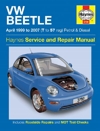
This manual covers:#9679; Hatchback (plus major mechanical features of Cabriolet) inc. special/limited editions. Does NOT cover Tiptronic transmission#9679; Petrol: 1.4 litre (1390cc) 1.6 litre (1595cc) 1.8 litre (1781cc) turbo 2.0 litre (1984cc). Does NOT cover 2.3 litre V5 engine.#9679; Diesel: 1.9 litre (1896cc) turbo inc. PDNOTE: Only maintenance adjustment minor repair procedures plus removal and installation are described for the transmissions.Inside this manual you will find: Routine Maintenance tune-up procedures engine repair cooling and heating air-conditioning fuel and exhaust emissions control ignition brakes suspension and steering electrical systems and wiring diagrams.Haynes repair manuals can save you money on maintenance and repair bills. Step-by-step procedures and illustrations guide you through every job from basic maintenance and troubleshooting to complete teardown rebuild.Information o
Volkswagen VW Super Bug 1600 1971 1975 Gregorys Service Repair Manual
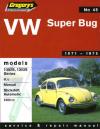
VW Volkswagen Superbug 1600 - 1302S 1303S 1971-1975 NEW paperbackOther VW Volkswagen Repair Manuals click here Volkswagen VW Super Bug 1600 1971 - 1975 Gregorys Owners Service Repair Manual covers the Australian spec Super Bug 1302S and 1303S series S and L fitted with the 1600c engine 4 cylinder engine.Engine Covered: Type 1 1600 (1584 cc) horizontally opposed 4-cylinderTransmissions covered: 4-speed manual 3-speed Stickshift Automatic NOTE: Only maintenance adjustment minor repair procedures plus removal and installation are described for the transmissions. Covers everything you need to know step by step procedures hundreds of photographs and illustrations routine maintenance wiring diagrams repairs and overhauls and what tools to buy. Gregory s manuals are based on an actual vehicle stripdown and are researched and written by automotive engineers with vast experience.
Volkswagen VW Beetle Karmann Ghia 1954 1979 Haynes Service Repair Manual
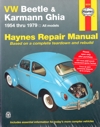
VW Volkswagen Beetle and Karmann Ghia Service and Repair Manual 1954 - 1979 HaynesGet Other Volkswagen Repair Manuals click here NEW softcover 318 pages US VW Beetle Karmann Ghia 1954 - 1979 Haynes Owners Service Repair Manual covers: Beetle 1954 - 1979 and Karmann Ghia 1956 - 1975.Engines covered (are all boxer 4-cylinder air-cooled): 1200 (1192 cc) 1300 (1285 cc) 1500 (1493 cc) 1600 (1584 cc) Single port 1600 (1584 cc) Dual port Transmissions Covered (no overhaul data for automatic): Split-case 4-speed manual Single-piece case 4-speed manual Automatic Stick Shift 3-speed semi-automatic - manual shift with torque converter and automatic clutch Inside this manual you will find: Routine Maintenance tune-up procedures engine repair cooling and heating air-conditioning fuel and exhaust emissions control ignition brakes suspension and steering electrical systems and wiring diagrams. Haynes repair manuals can save you money on maintenance and repair bills. Step-by-step procedures and illustrations guide you through every job from basic maintenance and troubleshooting to complete teardown rebuild.
Volkswage VW Beetle 1100 1500 1954-1971 Gregorys Service Repair Manual
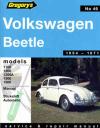
Get other VW repair manuals hereVolkswagen Beetle 1100 - 1500 1954 - 1971 Gregorys Owners Service Repair Manual covers 1100 1200 1200A 1300 and 1500 models fitted with the four-speed manual transmission (both the split casing box with synchromesh on 2nd 3rd and 4th and the later all synchromesh box) or the Stickshift automatic transmission.Engines covered are all horizontally opposed OHV 4-cylinder air-cooled in the following capacities: 1100cc 1200cc 1300cc 1500ccContents: Engine Fuel Clutch Stickshift Automatic Transmission Transmission and Rear Axle Steering Front Axle and Suspension Rear Suspension Brakes Electrical System Wiring Diagrams Body Wheels and Tyres Lubrication and MaintenanceNOTE: Only maintenance adjustment minor repair procedures plus removal and installation are described for the Transmissions.
How to Keep Your Volkswagen Alive
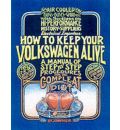
Get other VW repair manuals hereFirst published in 1969 this classic manual of automotive repair equips VW owners with the knowledge to handle every situation they will come across with any air-cooled Volkswagen built through 1978 including Bugs Karmann Ghis vans and campers. With easy-to-understand fun-to-read information- for novice and veteran mechanics alike-anecdotal descriptions and clear language this book takes mystery out of diagnostic maintenance and repair producers and offers some chuckles along the way. How to Keep Your Volkswagen Alive by John Muir
How to Rebuild Your Volkswagen Air-Cooled Engine 1961 onwards
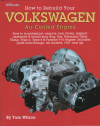
Rebuild Aircooled VW Engines HP255 by Tom WilsonGet other VW repair manuals hereA guide to engine rebuilding includes discussions of removal parts indentification cylinder head reconditioning and engine assembly Integracar tries to make available a diverse array of workshop guides. But owners manuals can be created for assorted countries and the motor cars engineered for those nations. That means not all service manuals may be acceptable for your particular car. If you have queries whether a particular repair manual is relevant for your automobile kindly contact us hereRebuild Aircooled VW Engines HP255 by Tom Wilson
Although crafted inside the 1930s, the Beetle was just yielded inside immense numbers from 1945 about whenever the model was internally designated the Volkswagen Type 1, plus advertised just because the "Volkswagen". Later models were designated VW 1200, 1300, 1500, 1302 or 1303, the previous 3 indicating engine displacement as well as the latter 2 being produced within the kind quantity plus not indicative of engine capability. The model became commonly acknowledged inside its house nation because the Käfer plus was later advertised as a result inside Germany, plus because the Volkswagen Beetle inside alternative nations.
In the 1950s, the Beetle was more comfortable plus effective than many European tiny vehicles, having been tailored for sustained excellent speed found on the Autobahn. It stayed a top seller inside the U.S., owing much of its achievement with significant build-quality plus innovative advertising, eventually offering rise with variants, including the Volkswagen Karmann Ghia as well as the Volkswagen Type 2 bus.
The Beetle had marked a noticeable trend led by Volkswagen, Fiat, plus Renault whereby the rear-engine, rear-wheel drive design had improved from 2.6 % of continental Western Europe's automobile manufacturing inside 1946 with 26.6 % inside 1956. The 1948 Citroën 2CV plus different European models marked a later trend with front-wheel drive inside the European tiny auto marketplace, a trend which might come with dominate which marketplace. In 1974, Volkswagen's own front-wheel drive Golf model succeeded the Beetle. In 1994, Volkswagen unveiled the Concept One, a "retro"-themed concept auto with a resemblance with the authentic Beetle, plus inside 1998 introduced the "New Beetle", built found on the Golf platform with styling recalling the authentic Type 1.
In a 1999 global poll for the world's many influential automobile of the 20th century, the Type 1 came 4th, following the Ford Model T, the Mini, as well as the Citroën DS.
Engines based found on the two-stroke cycle employ 2 strokes for each force stroke. Because there are no devoted consumption or exhaust strokes, alternative techniques should be selected with scavenge the cylinders. The most commonly known way inside spark-ignition two-strokes is with utilize the downward motion of the piston with pressurize fresh charge inside the crankcase, that is then blown by the cylinder from ports inside the cylinder walls.
Spark-ignition two-strokes are little plus light for their energy output plus mechanically extremely simple; though, they are furthermore commonly less effective plus more polluting than their four-stroke counterparts. In terms of force per cm³, a two-stroke engine produces similar force with an equal four-stroke engine. The benefit of getting 1 force stroke for each 360° of crankshaft rotation is balanced by the less complete consumption plus exhaust as well as the less efficient compression plus force strokes. It can be potential for a two-stroke with provide more energy than an similar four-stroke, over a narrow range of engine speeds, at the cost of less energy at additional speeds.
Small displacement, crankcase-scavenged two-stroke motors have been less fuel-efficient than many other kinds of motors whenever the gas is mixed with all the air before scavenging permitting a few of it with escape from the exhaust port. Modern designs use air-assisted gas injection, that avoids this reduction plus delivers more efficiency than comparably sized four-stroke machines. Fuel injection is important for a contemporary two-stroke engine for it to satisfy stringent emission specifications. The issue of total reduction oil expenditure, nonetheless, remains a cause of significant hydrocarbon emissions. The low-pressure direct gasoline injection developed by R Sarich was tested by Ford inside an car size 2-stroke engine, plus inside 2012, Orbital earned a contract by the Australia government for a two-stroke, direct injection engine for airborne drones.
Research continues into improving several aspects of two-stroke motors including direct gas injection, among additional items. The initial results have yielded motors which are much cleaner burning than their conventional counterparts. Two-stroke motors are popular inside snowmobiles, lawnmowers, string trimmers, chain saws, jet skis, mopeds, outboard motors, plus countless motorcycles. Two-stroke machines have the benefit of a improved particular force ratio, usually about 1.5 times that of the typical four-stroke engine.
The biggest internal combustion motors inside the globe are two-stroke diesels, employed inside several locomotives plus big ships. They utilize forced induction with scavenge the cylinders; an illustration of the kind of engine is the Wärtsilä-Sulzer turbocharged two-stroke diesel because utilized inside big container ships. It is the many effective plus effective internal combustion engine inside the globe with over 50% thermal efficiency. For comparison, the many effective little four-stroke motors are about 43% thermal efficiency; size is a benefit for efficiency due with the heighten inside the ratio of amount with surface location.
Common cylinder designs include the straight or inline configuration, the more compact V configuration, as well as the wider however, easier flat or boxer configuration. Aircraft machines could moreover follow a radial configuration, that enables more powerful cooling. More unusual designs including the H, U, X, plus W have moreover been chosen.
Multiple crankshaft designs never automatically want a cylinder head at all considering they may rather have a piston at every end of the cylinder called an opposed piston shape. Because here fuel in- plus outlets are placed at opposed ends of the cylinder, 1 may achieve uniflow scavenging, that, because inside the four-stroke engine, is effective over a variety of engine speeds. Also the thermal efficiency is improved due to shortage of cylinder heads. This shape was selected inside the Junkers Jumo 205 diesel aircraft engine, utilizing 2 crankshafts at either end of the single bank of cylinders, plus many remarkably inside the Napier Deltic diesel motors. These utilized 3 crankshafts with serve 3 banks of double-ended cylinders organized inside an equilateral triangle with all the crankshafts at the corners. It was additionally employed inside single-bank locomotive machines, plus continues to be chosen for sea propulsion machines plus sea auxiliary generators.
In occupied Germany, the Allies followed the Morgenthau program with eliminate all German war possible by complete or partial pastoralization. As element of the, inside the Industrial plans for Germany, the rules for that industry Germany was with be permitted with retain were set out. German automobile creation was set at a maximum of 10% of the 1936 auto manufacturing numbers.
Mass creation of civilian VW vehicles didn't commence till post-war job. The Volkswagen factory was handed over by the Americans with British control inside 1945; it was with be dismantled plus shipped with Britain. Fortunately for Volkswagen, no British automobile producer was interested inside the factory; "the car refuses to meet the basic technical requirement of the motor-car ... it happens to be quite unattractive with the average buyer ... To build the vehicle commercially will be a completely uneconomic enterprise." The factory survived by producing vehicles for the British Army rather. Allied dismantling plan changed inside late 1946 with mid 1947, though thick industry continued with be dismantled till 1951. In March 1947, Herbert Hoover aided change plan by stating
"There is the illusion which the New Germany left following the annexations is reduced with a 'pastoral state'. It can not be completed except you exterminate or move 25,000,000 individuals from it."
The re-opening of the factory is mostly certified with British Army officer Major Ivan Hirst. Hirst was ordered with take control of the seriously bombed factory, that the Americans had grabbed. His initially task was with eliminate an unexploded bomb which had fallen by the rooftop plus lodged itself between several pieces of irreplaceable manufacturing equipment; when the bomb had exploded, the Beetle's fate might have been sealed. Hirst persuaded the British military with purchase 20,000 of the vehicles, plus by March 1946 the factory was producing 1,000 vehicles a month, that Hirst mentioned "was the limit set by the supply of materials". During this period, the auto reverted with its authentic name of Volkswagen as well as the town was renamed Wolfsburg. The initial 1,785 Type 1s were produced inside 1945.
The jeweled one-millionth Type 1
After the British Army-led restart of creation, past Opel manager Heinz Nordhoff was furnished director of the Volkswagen factory. Under Nordhoff, manufacturing improved dramatically over the following decade, with all the one-millionth automobile coming off the assembly line by 1955. During this post-war period, the Beetle had superior performance inside its category with a top speed of 115 km/h plus 0100 km/h inside 27.5 seconds with gas expenditure of 6.7 l/100 km for the standard 25 kW engine. This was far superior with the Citroën 2CV, that was aimed at a low speed/poor road remote peasant marketplace, plus Morris Minor, crafted for a marketplace without motorways / freeways; it was even competitive with more advanced tiny city vehicles like the Austin Mini.
In Small Wonder, Walter Henry Nelson wrote:
"The engine fires up instantly without a choke. It has tolerable road-handling plus is affordable with keep. Although a tiny auto, the engine has awesome elasticity plus gave the sensation of greater output than its little nominal size."
Opinion inside the United States wasn't flattering, yet, maybe as a result of the characteristic variations amongst the American plus European auto markets. Henry Ford II when described the vehicle because "a small box." The Ford organization was available the whole VW functions following the war for free. Ford's right-hand guy Ernest Breech was asked what he thought, plus told Henry II, "What we're being available here, Mr. Ford, isn't value a really!"
During the 1950s, the vehicle was modified progressively: the apparent graphic changes largely worried the back windows. In March 1953, the little oval two-piece back window was changed with a somewhat greater single-piece window. More dramatically, inside August 1957 a much bigger full width back window changed the oval 1. 1964 saw the introduction of the widened cover for the light over the back licence plate. Towards the finish of 1964, the height of the side windows plus windscreen grew somewhat, offering the cabin a less pinched look: this coincided with all the introduction of the fairly somewhat curved windscreen, though the curve was hardly noticeable. The same body appeared throughout 1966, with a 1,300 cc engine inside area of the 1,200 cc: just inside the 1973 model Super Beetle did the Type 1 get an clearly curved windscreen. The flat windscreen stayed found on the standard Beetle.
There were furthermore changes below the bonnet. In 1954, Volkswagen added 2 mm with the cylinder bore, improving the displacement from 1,131 cc with 1,192 cc. This coincided with updates with numerous key components including a redesign of the crankshaft. This improved force from 33 bhp with a stated 40 bhp plus improved the engine's free revving abilities without compromising torque at lower engine speeds. At the same time, compression ratios were slowly raised because, small by small, the octane reviews of accessible gas was raised inside main markets throughout the 1950s plus 1960s.
There were additional, less-numerous models, also. The Hebmüller cabriolet, a stylish two-seater, was built between 1949 plus 1953; it numbered 696. The Type 18A, a fixed-top cabriolet, was yielded by Austro-Tatra because a authorities plus fire unit; 203 were assembled between January 1950 plus March 1953.
Beetle authorities vehicle inside Iran
Beetle sales boomed inside the 1960s, because of smart advertising advertisments, as well as the Beetle's standing for dependability plus sturdiness. On 17 February 1972, whenever Beetle No. 15,007,034 was yielded, Beetle creation surpassed which of the past record holder, the Ford Model T. By 1973, total manufacturing was over 16 million, plus by 23 June 1992, over 21 million had been yielded.
In 1951, Volkswagen prototyped a 1.3 L diesel engine. Volkswagen produced just 2 of these air-cooled boxer diesel machines, plus installed 1 engine inside a Type 1 plus another inside a Type 2. The diesel Beetle was time tested found on the Nürburgring plus attained 0100 km/h inside 60 seconds.
Introduction with Ireland
History of Volkswagen inside Ireland
Volkswagen started its participation inside Ireland whenever inside 1949, Motor Distributors Limited, founded by Stephen O'Flaherty secured the franchise for the nation at which years Paris Motor Show. In 1950, Volkswagen Beetles began arriving into Dublin packed inside crates inside what was termed "completely knocked down" shape willing with be assembled. The cars were assembled inside a past tram depot at 162 Shelbourne Road inside Ballsbridge. This really is today the premises for Ballsbridge Motors that are nevertheless a Volkswagen dealer. The initially Volkswagen ever assembled outside Germany was built here. This car is today about show at the Volkswagen Museum inside Wolfsburg.
Introduction with the UK
The initially Volkswagen Beetle dealer inside the UK was J.Gilder & Co. Ltd. inside Sheffield, that started marketing Volkswagens inside 1953. Jack Gilder had been fascinated by both the shape plus technology of the Beetle whenever he came over 1 inside Belgium throughout the war. He used for the franchise because shortly because the chance presented itself plus became Volkswagen's representative inside the North of England.
VW Beetle 19531957
1956 Volkswagen
During this period, the back window of the VW Beetle evolved from a split or "split" oval, with a singular oval. The change happened between October 1952 plus March 1953. Beetles built throughout this time were recognised as a "Zwitter", or "hybrid", because they chosen the split-window bodyshell with oval-model chrome trim, vent windows plus dashboard. Steel chosen for the bodywork was at its ideal standard, as well as the Wolfsburg emblem at the tip of the front of the bonnet became a complex fabrication. The back 'W' decklid was hand-fabricated. The front wing had a specific 'flare out'.
VW Beetle 1967
1967 Volkswagen Beetle Platform 113 series
Engine 1,493 cc OHV H4
Transmission 4-speed manual
Wheelbase 2,400 mm
Length 4,079 mm
Width 1,539 mm
Curb fat 800840 kg
The Beetle changes for the 1967 model included a larger-displacement engine for the next year inside a row. Horsepower had been improved with 37 kW the past year, as well as for 1967 it was improved with 53 PS at 4,200 rpm. Torque is 10.8 kg·m at 2,000 rpm, bore 83 mm, stroke 69 mm, plus it has a compression ratio of 7.5:1. The 1200 plus 1300 motors continued with be obtainable in the up-to-date bodyshell, because numerous markets based their taxation about engine size.
On US, UK, plus Ireland models, the generator output was improved from 180 with 360 watts, plus upgraded from a 6-volt with a 12-volt program. The clutch disk moreover improved inside size, plus changes were prepared with the flywheel, braking program, plus back axle. New standard equipment included two-speed windscreen wipers, reversing lights, a driver's armrest found on the door, locking buttons found on the doorways, along with a passenger's side outdoor mirror.
The 1967 model weighed 840 kg inside federal trim, 800 kg inside Europe.
That same year, inside accord with all the newly enacted US Federal Motor Car Safety Standard 108, the well-defined glass headlamp covers were deleted; the headlamps were brought forward with the leading edge of the front fenders, as well as the sealed-beam units were exposed plus encircled by chrome bezels. For the 1968 model year, Beetles available outside North America received the same more upright plus forward headlamp location, yet with replaceable-bulb headlamps compliant with ECE laws instead of the US sealed beams.
Super Beetle plus final evolution
VW 1303
In 1971, a modern Beetle model featuring MacPherson strut front suspension along with a redesigned front end was introduced alongside the "standard" Beetle, that continued inside creation. Officially recognised as the VW 1302 from 1971 with 1972, plus VW 1303 from 1973 onwards, nevertheless commonly called Super Beetle, the new stretched nose shape changed the double parallel torsion bar beams that had compromised torso room plus relocated the spare tire from a close vertical with a low horizontal position. The redesign lead to a tighter turning radius despite a 20 mm longer wheelbase, along with a doubling of the front compartment's cargo amount. As with past models, air stress within the spare tire pressurized the windshield washer canister, inside lieu of a electrical pump.
1972 Super Beetles had an 11 % greater back window taller), bigger front brakes, 4 rows of vents found on the engine deck lid, tail lights incorporating reverse lights, a four-spoke energy-absorbing steering wheel plus steering column, plus an engine compartment socket for the proprietary VW Diagnosis program.
1973-1974 Volkswagen 1303/Big
In 1973, the VW 1303 introduced a curved windscreen, forced forward plus away within the travelers, permitting a redesigned, padded dashboard with substitute the pre-1973 vertical dash. A two-speed heater enthusiast, high back mudguards, plus bigger tail lights were added. The changes with the heater/windshield wiper housing plus curved windshield lead to slight redesign of the front bonnet, creating the 1971 plus 1972 Super Beetle hoods distinctive. In late 1973, the well-equipped "1303/Big" unique edition was introduced because consumers were searching for less spartan vehicles. These have 15-inch wheels, metallic paintwork, a more luxurious interior, a heated back windshield, plus other comforts.
For 1974, the past flat steel bumper mounting brackets were changed with tubular "self restoring power absorbing" attachments, effectively shock absorbers for the bumpers, about North American marketplace Beetles. These vehicles moreover got stronger "5 mph" bumpers which added an inch with the size of the auto. The steering knuckle plus consequently the lower connection point of the strut was redesigned with enhance handling plus stability inside the event of the tire blowout. This signifies struts from pre-1974 Super Beetles are not interchangeable with 197479s.
1975 models showcased Air Flow Control Fuel Injection about U.S., Canadian, plus Japanese Beetles, a derivative of the more complex Bosch gas injection program selected inside the Volkswagen Type III, plus equal with Bosch L-Jetronic. The fuel-injected engine moreover received a modern muffler as well as the way of a upstream catalytic converter necessary about several models, necessitating a bulge inside the back apron sheet metal straight below the back bumper, plus changing the distinctive double "pea shooter" pipes with a single offset tailpipe, generating fuel-injected models identifiable at a glance. Other changes were rack plus pinion steering substituting the conventional worm plus roller gearbox about Super Beetles, along with a bigger license plate lamp housing under the engine lid. The front turn indicators were moved within the top of the fenders into the bumper bars about European models.
In 1976, the optional Autostick transmission as well as the Super Beetle sedan were discontinued, with VW continuing with market the standard sedan plus VW 1303 convertible. 1976-on convertibles received no immense technology changes, just a limited aesthetic touches plus unique paint choices, including the "Champagne Edition" models with the final 1979 "Epilogue Edition" black about black, inside salute with the initially Beetles yielded inside the 1930s. 1977 model sedans received front seats with separate head restraints.
Beetle cabriolet
1960 VW 1200 Cabriolet
VW 1300 with an aftermarket rainfall shield over the engine hatch air vents.
The Beetle Cabriolet started manufacturing inside 1949 by Karmann inside Osnabrück. It was inside 1948 which Wilhelm Karmann initially purchased a VW Beetle sedan plus converted it into a four-seated convertible. After effectively presenting it at VW inside Wolfsburg, manufacturing began inside 1949. After a amount of stylistic plus technical changes created with the Karmann cabriolet,, the last of 331,847 cabriolets came off the conveyor belt about 10 January 1980.
Decline
Though very lucrative inside the 1960s, the Beetle was confronted with stiff competition from more contemporary designs. The Japanese had processed rear-wheel-drive, water-cooled, front-engine little vehicles so they available perfectly inside the North American marketplace, plus Americans introduced their own similarly sized rear-wheel-drive Chevrolet Vega, Ford Pinto plus AMC Gremlin inside the 1970s. The superminis inside Europe adopted more effective transverse-engine front-wheel-drive layouts, plus sales started dropping inside the mid-1970s. There had been many unsuccessful tries with substitute or supplement the Beetle inside the VW product line throughout the 1960s; the Type 3, Type 4, as well as the NSU-based K70 were all less lucrative than the Beetle, though aimed at more upscale markets for that VW lacked credibility. The over-reliance found on the Beetle meant which Volkswagen was inside financial crisis by 1974. It required German government funding with make the Beetle's substitution. Just whenever manufacturing lines at Wolfsburg turned with the modern watercooled, front-engined, front-wheel drive Golf tailored by Giorgetto Giugiaro inside 1974, did Volkswagen provide a auto because lucrative because the Beetle. The Golf will be periodically redesigned over its life, entering its seventh generation inside 2012, with just a some components carried over between decades, when the Beetle had just minor refinements of its authentic shape.
The Golf didn't kill Beetle creation, that continued inside small numbers at alternative German factories till 19 January 1978, whenever mainstream creation changed with Brazil plus Mexico: markets where low running expense was significant. The Beetle Cabriolet was yielded for the North American plus European markets inside Germany till 10 January 1980. The last Beetle was yielded inside Puebla, Mexico, inside July 2003. The final batch of 3,000 Beetles were available because 2004 models plus badged because the Última Edición, with whitewall wheels, a host of earlier discontinued chrome trim, as well as the choice of 2 unique paint hues taken within the New Beetle. Production inside Brazil ended inside 1986, then began again inside 1993 plus continued till 1996. Volkswagen available Beetle sedans inside the US till August 1977 plus inside Europe till 1985, with private businesses continuing with import vehicles yielded inside Mexico following 1985.
The Beetle outlasted many different vehicles that had copied the back air-cooled engine design including those by Subaru, Fiat, plus General Motors. Porsche's sport coupes that were initially based about Volkswagen components plus platforms continue with employ the classic back engine design inside the Porsche 911 series, that remains competitive inside the 2nd decade of the 21st century.
The Volkswagen Beetle was introduced with Mexico inside March 1954, inside the exhibition "Alemania y su Industria". Four different Volkswagen cars were brought with Mexico from Veracruz City for the very first time. Those cars were: 2 Sedans 113 inside "Export" trim, a convertible, along with a VW Bus inside deluxe trim.
At this time, the Mexican automobile marketplace was largely characterized by American makes plus models with big models plus big motors, that produced a big comparison with all the hot German entrant. An exhibition was held inside the Ciudad Universitaria inside Mexico City; throughout this event, the cars were commonly admired by the public. The Volkswagen Beetles shown there were the model with all the "oval window". Former Mexican president Lázaro Cárdenas created a trip from Michoacán, only to see this peculiar car. The nearby click instantly published the information into 8 columns below the title "The People's Man" with all the "People's Car".
In reaction with doubts in regards to the Beetle's long-term dependability, Prince Alfonso de Hohenlohe, descendant of the friend of Ferdinand Porsche along with a auto enthusiast resident of Mexico City, decided with enter 7 VW sedans inside 1954's Carrera Panamericana competition. The Beetles completed the 3211 km race. While none completed inside initial destination, the VWs all had 4-cylinder 1.2 L machines. Many magazines reported rumors which the motors were Porsche rather of Volkswagen. An expert mechanic from Houston, Texas, was asked with examine the vehicles plus qualified which they had authentic, unmodified VW motors. This led with the creation of the organization Volkswagen Mexicana, S.A. In the same year, Hohenlohe founded the Distribuidora Volkswagen Central, S.A. de C.V., that opened its doorways the following year because Mexico's first